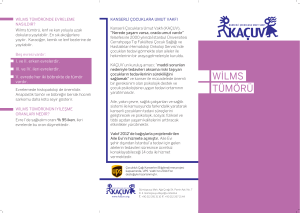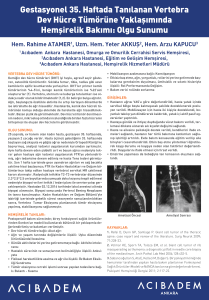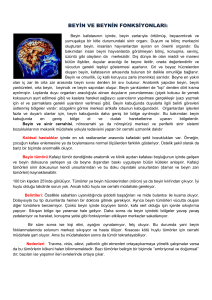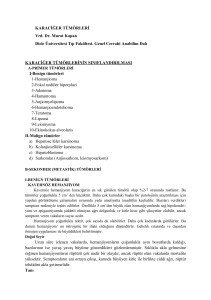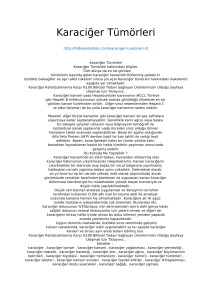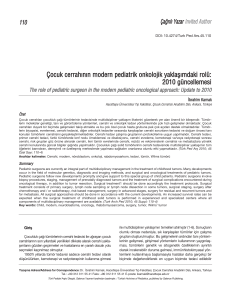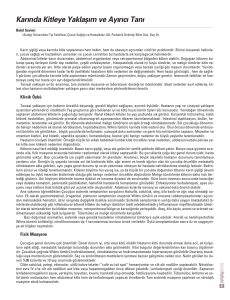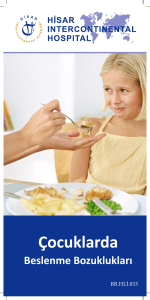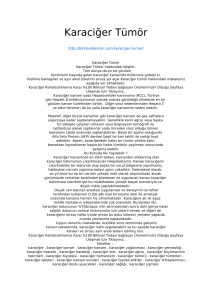çocukluk çağı tümörleri
advertisement
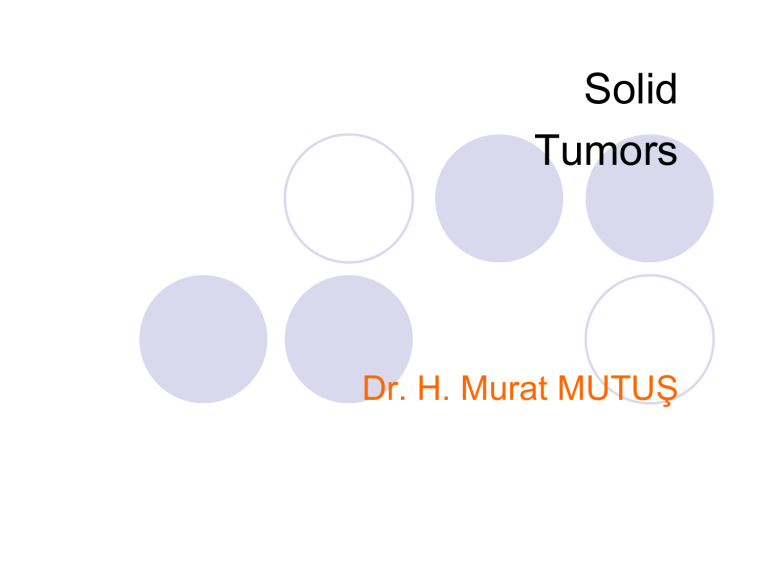
Solid Tumors Dr. H. Murat MUTUŞ Wilms’ Tumor Also called as Nephroblastoma One of the most common solid tumors of pediatric age group Seen in frequency of 8/106 under the age of 15 years Frequency varies according to geographical areas Age, Sex and Bilaterality: Male/Female ratio=1/1,1 Mean age of admittance is around 3,5-4 years Bilateral Wilms tumor is seen in 7% of cases Associated anomalies accompanying Wilms’ Tumor Aniridia, Hemihypertrophy Undescended testis, Hypospadias Male pseudohermaphroditism Renal hypoplasia Renal ectopia Duplication anomalies Horseshoe kidney Syndromes accompanying Wilms’ Tumor WAGR syndrome Wilms’ Tumor, aniridi,a genitourinary malformations, mental retardation Wiedemann- Beckwith syndrome (WBS) Macroglossia, organomegaly, hemihypertrophy, abdominal wall defects, hypoglycemia, earbud deformities Drash syndrome Pseudohermaphrotidism, degenerative kidney diseases Klippel-Trenaunay syndrome Perlmann syndrome Specific cytogenetic anomalies •Wiedemann- Beckwith syndrome (WBS) •Macroglossia •Organomegaly •Hemihypertrophy •Abdominal wall defects •Hypoglycemia •Earbud deformities Wilms’ Tumor Aniridia 1000 times higher risk for development of Wilms’ Tumor All children with aniridia should be physically examined and evaluated by abdominal ultrasound every 3 months in first 2 years, snd and every 6 months until 4 years of age Hemihypertrophy: 1000 times higher risk when compared with normal population Such cases should be followed same as in aniridia Wilms’ Tumor Genitourinary anomalies While incidence of undescended testicle and hypospadias are 0,7% and 1,0% in normal population, in Wilms’ tumor cases this ratio is 5,2% Incidence of bilateral tumors are higher in this group of patients with genitourinary anomalies (25%) Familial Wilms’ tumor Family history is 1.5% in Wilms tumor Bilaterality is higher in familial cases (16%) Table. Rate of congenital anomalies and syndromes seen in Wilms’ tumor patients. NWTS group results between the years 1980 and 1999. Anomaly, Syndromes Patient number Prevalance (%0) Wilms Tumor, aniridia, genitourinary malformation, mental retardation (WAGR) syndrome 52 7,5 Denys-Drash syndrome 28 4,0 Beckwith-Wiedeman syndrome 74 10,7 Sporadic hemihypertrophy 171 25,1 Undescended testicle (male patients) 49 46,6 Hypospadias (male patients) 64 20,0 Molecular Genetics: Wilms’ tumor gene WT-1 gene; a tumor supressor gene located in p13 arm of chromosome 11 (11p13). This gene is deleted in all children with WAGR sendrome. In sporadic Wilms’ tumor patients, deletion is seen in 5-10 % of cases. WT-2 gene (11p15) is also a supressor gene. Other genetic anomalies are seen. Eg: p53 supressor gene plays a role in aggressive form of Wilms’ tumor. Clinical findings / Symptoms Abdominal mass Generally first sign Hypertension Hematuria Clinical findings / Symptoms A large, regular surfaced, smooth mass may be palpated The lesion generally is not painful, and is relatively immobile Generally does not cross the midline Abdominal pain, fever, and anemia may occur intraperitoneal or subcapsular bleeding is a result of tumor necrosis. Therefore, when this occurs, it is difficult to differentiate from Neuroblastoma İntravenous involvement cardiac murmur, hepatosplenomegaly, ascites, varikocele and gonadal metastasis Generally metastasizes to lungs DIAGNOSIS / Imaging Routinely; Chest X-Ray Abdominal plain graphy, followed by USG and CT and/or MRI Nature of the mass, and the organ of origin, Contralateral renal parenchymal evaluation, Presence of Bilateral disease, Patency of VCI ve renal vein Presence of distant metastasis. IVP USG CT Metastasis Blastomatozis Wilms Wilms + Adenopathy Wilms + Adenopathy + Capsular Invasion Bilateral Wilms’ Tumor -MRI Bilateral Wilms Bilateral Wilms Pathology Composed of blastemal, stromal or epithelial elements. Any cell type may be dominant, or there may be mixed tissue pattern Histopathologically; “favorable or unfavorable histology” / The most important prognostic factor Pathology Nephroblastomatosis (Nephrogenic rest) accepted as a premalignant lesion Histologically it is a persistant metanephric tissue Has a clear relationship with Wilms’ tumor They are found in 1% of postmortem autopsies of normal population, but seen as frequent as 25-40 % of Wilms’ tumor patients They are the most important findings for increased risk of future contralateral Wilms’ tumor occurance Nephrogenic rest Wilms T-NWTS-5 Staging System Stage I: Tumor limited to kidney and totally resectable – Renal capsule is intact Stage II: Tumor extending beyond kidney, but still totally resectable Stage III: Residual nonhematogenous tumor present, but limited to abdomen Stage IV: There is hematogenous or lymph node metastasis extending beyond abdominopelvic area Stage V: There is bilateral kidney involvement during diagnosis Stage 1 Tumor limited to kidney and totally resectable – Renal capsule is intact Stage 2 Tumor extending beyond kidney, but still totally resectable Stage 3 Residual nonhematogenous tumor present, but limited to abdomen Stage 4 There is hematogenous or lymph node metastasis extending beyond abdominopelvic area Stage 5 There is bilateral kidney involvement during diagnosis Surgical Treatment 2 basic responsibility of surgeon exists: Complete resection of the WHOLE viable tumor tissue, Supply correct information required for staging In most cases unilateral radical nephroureterectomy is performed The presence of venous involvement or contralateral disease should be evaluated, and if diagnosed, specific surgical procedures should be done accordingly Continued clinical studies named “National Wilms’ Tumor Study1,2,3,4,5” develop treatment modalities of radiation and chemotherapy . These protocols are used as adjuvants to surgical treatment. CLEAR CELL SARCOMA Known as bone metastasizing renal tumor in children. They resemble to WT with UH. 25% of cases metastasize to bone. Important histological features; fibrovascular septae formation in tumor with vascular arcus formation and division of tumor cells into chords or columns Multicentric or bilateral clear cell sarcoma has not been reported In treatment all patients undergo nephrectomy, radiotheraphy, and chemotheraphy as a standart approach. If bone metastasis present, long term survival is very low (16%) RHABDOID TUMORS o Rare but very fatal o They are thought to origin from neural crest cells of renal medulla o Consist of %2 of renal tumors o Hypercalcemia may be seen o Differential diagnosis from WT is possible by CT has been reported o All cases are unilateral o May metastasize to anywhere, but most frequently to lungs o Surgery, chemotherapy and radiotherapy are used for treatment, but results are not satisfactory RENAL ADENOCARCINOMA They are very rare tumors in children. Most frequently seen in late childhood, or in adolescents. In adult forms, the triad of abdominal pain, hematuria, and flank mass is classical; but in children and adolescents, this is not so common. Metastasize to lungs, liver, and bone. Prognosis depends on clinicopathological stage. Recommended treatment is; radical nephrectomy+regional lymphadenectomy. Expected survival rate is around 50%. Chemotherapy and radiotherapy may also be added to treatment. CONGENİTAL MESOBLASTİC NEPHROMA •Most common renal tumor in first 3 months of life •After 4. month, Wilms’ tumor is most common •5% of all pediatric renal tumors •More than %90 are seen in 1st year of life •Twice more common in male children •Most common age of admittance is between 3-4 months of age CONGENİTAL MESOBLASTİC NEPHROMA •The most common presenting sign is a palpable mass in the abdomen •Hematuria may rarely be seen •May be diagnosed prenatally •Polihydramnios may be present •Preterm delivery, low birth weight, and hydrops faetalis may occur CONGENITAL MESOBLASTIC NEPHROMA •No Bilateral lesion reported •Treatment is surgical removal •%95 cure with surgery only, •%5 recurrence possible •USG follow up after surgical removal is necessary •Although this tumor has a relatively benign character, it may rarely act agresively CONGENITAL MESOBLASTIC NEPHROMA CONGENITAL MESOBLASTIC NEPHROMA CONGENITAL MESOBLASTIC NEPHROMA Longitudinal section of kidney showing large blood clot occupying upper and middle poles with thinned cortex CONGENİTAL MESOBLASTİC NEPHROMA Low-power photomicrograph showing cystic area, large fibrous strand, and innumerable small, round cells in renal cortex typical of mesoblastic nephroma Multicytistic nephroma Bilateral Multicystic Nephroma Leucemic Renal Involvement Neuroblastoma Neuroblastoma Neuroblastoma Develops from Neural crest cells Sympathoganglia and adrenal medulla constituting symphatic nervous system ganglia Neuroblastoma Incidence: May differ with race Asia 7-12 /1 million/year 6-10% of all childhood cancers 30% at first year of age, 50% 1-4 years, and 5% after 10 years M/F = 1,3/1 ; slightly more common in males Neuroblastoma Etiopathogenesis: No known etiologic agent Mostly sporadic. Rare familial cases reported (Mostly in form of multiple primary tumor) In early fetal life, neuroblasts migrate from paravertebral ganglia into adrenal medulla. During neoplastic development, the tumor invades vascular and neighbouring structures as well as local involvement. Neuroblastoma Metastasis: Lymph node, bone, bone marrow, liver and skin Except the patients with Stage 4S disease, tumor dissemination is related with primary tumor mass, and may be seen in advanced disease Neuroblastoma Histopathology: Macroscopically soft mass. Necrotic and hemorhagic areas may occur “Rosette Formation”, a ring formed by neuroblasts around a neurofibrillary nucleus is a characteristical finding, but may not be seen in every case Histopathologically SHIMADA staging system is used; presence of a stroma, level of NB cell differentiation and nuclear morphology (mitosis and karyorrhexis index) are evaluated Mitosis-karyorrhexis index (MKI) calculated (= counts of mitotic or karyorrhectic cells per 5000 cells) <100 cell/5000 .....low 100-200.................intermediate >200........................high index. Two prognostic groups: Good and Bad prognosis Neuroblastoma Tumor localization: Adrenal medulla 50-60% Retroperitoneal 20% Mediastinum 10% Pelvis 2-6% Neck 2% Metastatic disease is present in 62-70% of cases during admittance In Localised disease 25% In Stage4S 10% Neuroblastoma Tumor Markers: More than 85% of NB secrete high amount of catecholamine metabolytes Most common vanilylmandelic acid (VMA) and homovanillic acid (HVA) VMA is an end product of adrenaline and nonadrenaline metabolism HVA is the metabolyte of dopa ve dopamine NB screening and diagnosis is possible by measuring blood and urine levels of these two metabolytes Neuroblastoma Tumor Markers: Biochemical: Neuron Specific Enolase (NSE): A glycolytic enzyme excreted by central and peripheral nerve and neuroblastic cells. Levels above 15 ng/ml are abnormal. Levels above 100ng/ml are correlated with advanced disease and low survival rates Lactic Dehydrogenase (LDH): Levels below 1500 IU/ml are related with better survival rates Ferritin: Neuroblastoma cells produce ferritin. High levels of ferritin in early stages is not a usual finding. Levels above 142 ng/ml are seen in Stage 3 or 4 disease and indicates bad prognosis Neuroblastoma Molecular: N-myc proto-onkogene, diploid DNA content (Hyperdiploidy), Deletion of Chromozome 1p, CD44 expression, Trk-A, MRP gene or protein Neuroblastoma Staging: Various staging systems are present Neuroblastoma-Pediatric Oncology Group Staging System Neuroblastoma Clinical presentation: Sign and symptoms associated with abdominal mass or presence of metastasis: Nausea, weight loss, fever, malaise, etc general nonspecific symptoms May initially misdiagnosed as juvenile rhomatoid arthritis when bone or joint pain occurs with metastasis Periorbital ecchimosis or proptosis may be the first sign Tumor may be visible if located in the neck Horner syndrome may be seen in apical thoracic tumors Changes in bowel and/or bladder functions or sphincter problems indicate pelvic tumors Neuroblastoma Clinical presentation: Majority of abdominal tumors are diagnosed by symptomatic metastatic involvement of the disease Locomotor disturbances and progressive paraplegia may be seen in some NB patients Physical Examination: Abdominal neuroblastoma lesions are generally hard, irregular surfaced, and fixed masses May be soft and ballotable in babies Pelvic tumors may be palpated during abdominal or rectal examination Neuroblastoma Clinical presentation: Multiple skin lesions may be seen in babies with Stage IVS disease. Abdominal distention may be present because of massive hepatomegaly Hypertension is present in 19% of newly diagnosed cases and generally associated with catecholamine secretion or renal artery compression No defined correlation exists betweeen blood pressure and urinary catecholamine secretion Hypertension is normalised after tumor resection or chemotherapy Neuroblastoma Clinical presentation: Paraneoplastic syndromes Opsomyoclonus (jumping eyes) syndrome; Characterized by progressive cerebellar ataxia More than half of these patients have primary thoracic tumors. These are more common in ganglioneuroma and ganglioneuroblastoma than in neuroblastoma Persistent diarrhoea is rare, and if present, may be associated with vasoactive intestinal peptide secretion by the tumor Neuroblastoma Racoon eyes Massive hepatomegaly (StageIVS) Neuroblastoma Diagnosis: Tissue diagnosis is also necessary to confirm the suspected clinical condition after laboratory and radiological evaluations. After that, staging should be done Laboratory work up: First diagnostic evaluation is determination of blood and urinary catecholamine metabolyte levels. Urinary VMA and HVA levels are high in most of the NB cases. Additionally CBC, serum biochemistry, liver and kidney function tests, serum ferritin, LDH ve NSE also measured. Neuroblastoma Diagnosis: Imaging: Plain x-rays (Upright abdominal plain graphy, Chest xray, bone scan) USG, Contrast enhanced CT or MRI and MIBG scintigraphy Plain x-ray; In more than 50% of cases, dystrophic calcifications are present Mediastinal tumors may be observed in chest x-ray USG differentiates among cystic and solid masses. No specific diagnostic USG feature is present in NB. A mixed echo pattern of calcification and necrotic areas may be observed. In pelvis and thorax, USG has a limited value. Imaging: Contrast enhanced CT or MRI is necessary for a correct and thorough anatomic detail of the tumor MRI Soft tissue changes, liver involvement, and intraspinal invasion (dumbell tumor) Superior to myelography, and may also show bone invasion Skeletal invasions may be seen as periostal erosion, radiolucency, and pathological fractures in plain x-rays. But bone and bone marrow involvements are best determined by radioisotopicly signed “metaiodobenzylguanidine (MIBG)” scintigraphy. MIBG may give false negative results Therefore, in MIBG negative cases Tc99m methylene diphosphonate (MDP) bone scintigraphy is used Neuroblastoma NöroblastomNeuroblastoma MIBG sintigrafisi Tümör Neuroblastoma Diagnosis: Tissue biopsy: Tissue biopsy is essential in diagnosis. Tissue may be obtained by bone marrow aspiration, or by biopsy of primary or secondary tumor tissue. Sufficient amount of tissue specimen should be obtained for diagnostic and cytogenetic tests. Nöroblastoma Tedavi: Nöroblastomun tedavisi multidisiplinerdir. Tedavi; cerrahi, kemoterapi ve radyoterapi içerir. Cerrahın rolü; mümkün olduğunca tümörün çıkarılması, gerekirse biyopsi alınması ve vasküler yolun sağlanmasıdır. Nöroblastoma Prognoz 1970’li yıllarda 5 yıllık sürvi oranı %15 iken günümüzde oldukça iyi bir duruma gelmiştir. 1980 –1990 yılları arasında tüm sürvi oranı %58 olarak hesaplanmıştır. Prognozu etkileyen birçok faktörler vardır. Nöroblastoma Prognostik faktörler Ganglonöroma’ya maturasyonu: Nöroblastoma spontan olarak regrese olabilen tek tümördür. Bunun insidansı bilinmiyor. Çok yeni taramalar göstermiştir ki; tedavi edilmemiş tümörlerde spontan regresyon olmuştur. Nöroblastoma Prognostik faktörler Erken tanı ve tarama Antenatal olarak saptanan tümörler favorable biyolojik profil gösterir. Tarama sonucu bulunan tümörler “favorable” olup ve sürvi şansı %92’dir. Bu grupta spontan regresyon sıktır. Nöroblastoma Prognostik faktörler Biyokimyasal ve Moleküler Marker: Bahsedilen çeşitli marker varlığı veya düzeyleri tümörün akıbetini etkiler. Nöroblastoma Prognostik faktörler Başvuru yaşı: 1 yaş altında tanı almış çocuklarda sürvi oranı %84 iken 1 yaş üstündekilerde %42 dir. Nöroblastoma Prognostik faktörler Paraneoplastik sendromlar Paraneoplastik sendromların görüldüğü hastalarda mortalite oranı sürpriz bir şekilde düşüktür. Nöroblastoma Prognostik faktörler Orijin aldığı yer 1970’lerde sürvi oranları servikal ve pelvik primer tümörlerde %100, torasiklerde %75 ve abdominal tümörlerde %28 di. 1990’ların ortalarında torasiklerde %83 olarak bildirilmiştir. Servikal ve torasik primer tümörü olan bebeklerin çoğunluğunda hiperdiploid DNA kontenti görülür. Spinal kanala uzanımı Dumbbell tümörlerinde yüksek sürvi oranıları söz konusudur. Nöroblastoma Prognostik faktörler Evreleme ve Stage IVS Düşük evrelerde sürvi daha yüksektir. Evre IVS hastalarda sürvi %50 civarındadır. Adjuvan terapi: Lokal olarak yayılmış veya metastatik hastalıklar için, myeloablative tedavi ile kombine multiajan kemoterapi sürvi oranını artırmıştır. Nöroblastoma-Prognozu etkileyen faktörler Faktör İyi Prognoz Kötü Prognoz Yaş <1 yaş >1 yaş Evre I, II, IV-S III, IV Shimada histoloji Stroma zengin Stroma fakir Yeri Mediatenum, pelvis, boyun Adrenal, çölyak aks >10 N-myc kopyası Hayır Evet DNA-flow sitometri Hiperdiploid Diploid Yükselmiş trk-A Evet Hayır Yüksek serum Ferritin Nöron-spesifik enolaz Laktat dehidrogenaz Hayır Hayır Hayır Evet Evet Evet Kr. 1 heterozigosite yokluğu Hayır Evet Multidrug rezistant-gen Hayır Evet Multidrug rezistant protein-gen Hayır Evet Somatostatin reseptörleri Evet Hayır Vazoaktif intestinal peptid sekresyonu Evet Hayır MHC class 1 antijeni Evet Hayır Tarama sonucu saptanma Evet Hayır Karaciğer Tümörleri Karaciğer Tümörleri Çocukluk çağında hepatik orijinli tümörler sık olmamasına karşın tüm karaciğer lezyonlarının yaklaşık ¾ ü malign’dir. Pediatrik hepatik kanserlerin %90’dan fazlasını Hepatoblastoma (HB) ve Hepatocellular carsinoma (HCC) oluşturur. Primer hepatik malignansilerin %65’ini HB, %25’ini HCC oluşturur Çocukluk çağı primer hepatik tümör insidansı Tümör İnsidans (%) Hepotoblastoma 43 Hepatoselüler Ca 23 Sarkom 6 Benign vasküler tümör 13 Mezenşimal hamartom 6 Adenoma 2 Fokal nodüler hiperplazi 2 Diğerleri 5 Karaciğer Tümörleri HB ve HCC; insidans oranları, epidemiyolojik özellikler, tedaviye cevap ve prognoz yönleriyle birbirinden oldukça farklıdırlar. Karaciğer Tümörleri EPİDEMİYOLOJİ HB; tipik olarak 1-3 yaş çocuklarda gelişen bir embriyonel tümördür. Olguların çoğunluğu sporadiktir. Ancak bazı spesifik sitogenetik anormalliklerde rölatif artış olabilir. En sık kromozom 2 ve 20’nin trizomisi ve kromozom 11’in kısa kolunda heterozigosity yokluğu dikkati çeker. Karaciğer Tümörleri EPİDEMİYOLOJİ HB; Beckwith-Wiedeman sendromlu (BWS) çocuklarda yüksek sıklıkta görülür. Aynı zamanda hemihipertrofili, renal ya da adrenal agenezili kişilerde ve familial adenomatöz polipozisili olguların çocuklarında sıklığı artar. BWS geninin yerleştiği 11p15; tümör süpresor lokusunun varlığını gösterir. Karaciğer Tümörleri EPİDEMİYOLOJİ HCC; çocukluk çağında erişkindeki gibi agresif biyolojik davranış gösterir. Sıklıkla; daha önceden karaciğer hastalığı olan kişilerde ve hepatit B’nin endemik olduğu Afrika ve Asya’nın belli bölümlerinde görülür. Bu bölgelerde HCC insidansı 200 kez daha sıktır. Bu ülkelerde en sık görülen primer karaciğer tümörü HCC’dir. Hepatit B infeksiyonun yüksek olan popülasyonlarda hepatit B aşısı ile rutin immunizasyon bir efektif kanser kontrol stratejisidir. Karaciğer Tümörleri EPİDEMİYOLOJİ HCC; metabolik ve inflamatuvar hepatopatilerin diğer tiplerine sahip hastalardada gelişebilir. Tirozinozis, glikojen depo hastalığı, alfa-1 antitripsin eksikliği, neonatal hepatit ve bilier atrezi gibi durumlar HCC gelişimi için yüksek risk oluştururlar. Karaciğer Tümörleri KLİNİK HB; tipik olarak ilk 3 yaş sırasında (ort:3,5 yaş) görülür HCC’li olguların çoğunluğu okul çağı çocuğudur. (ort 11,2 yaş). Her iki tümör de erkek çocuklarda fazla görülmektedir (erkek/kız oranı 3/1 dir). Abdominal kitle %68, abdominal distansiyon %28, anoreksi %23, kilo kaybı %23 abdominal ağrı %19 ve kusma %11 görülür. Ateş ve trombositozis sıklıkla gözlenir. Karaciğer Tümörleri TANISAL GÖRÜNTÜLEME Hem preoperatif tanıda hem de postoperatif izlemde radyolojik tanısal görüntüleme önemlidir. Diagnostik görüntülemede amaç; benignmalign ayırımı, tanının belirlenmes ve rezeke edilebilirliğin belirlenebilmesidir. Bu amaçla ; standart abdominal ve toraks radiografileri alınır. Daha sonra abdominal ultrasonografi (US) önerilir. Karaciğer Tümörleri TANISAL GÖRÜNTÜLEME US; kitlenin sınırları, uzanımı (solit/multifokal), komşulukları, natürü (kistik/solid veya karışık), kanlanması ve kan damarları hakkında yararlı bilgiler sağlar. US hatta perkütan biopsi amacıyla kullanılabilir. Bazen da intraoperatif olarak tümörün uzanımını belirlemede kullanılabilir. Karaciğer Tümörleri TANISAL GÖRÜNTÜLEME CT ve MRI incelemeleri de mutlaka yapılması gerekir. MRI; Tümörün hepatik vasküleriteye komşuluklarını tam belirlemede CT’den üstünlükleri vardır. Her hastaya preoperatif olarak, metastatik hastalık açısından toraks CT’si çekilir. Pulmoner metastazlı çocuklar ve ekstensif bilobar veya multifokal tümörlü olgular properatif kemoterapi adayıdırlar. Majör karaciğer rezeksiyonunda komplikasyon sıktır. Karaciğer Tümörleri TANISAL GÖRÜNTÜLEME MRI ve spiral CT’nin ilerlemesi ile, arteriografi çocukluk çağı hepatik tümörlülerde tanısal amaçlı nadir kullanılmaktadır. Arteriografi sıklıkla terapötik amaçlı (kemoembolizasyon ve sitotoksik ilaçların intraarterial infüzyonu) kullanılır. Günümüzde diagnostik arteriografi belki inkomplet rezeksiyon yapılmış ve reoperasyon planlanan olgular için rezerve edilmelidir. Karaciğer Tümörleri LABORATUVAR ÇALIŞMALARI CBC, trombosit sayımı, koagülasyon profili, ve karaciğer fonksiyon testleri çalışılmalıdır. Anemi sık görülür. Trombositozis, hastaların %60’ı oranında olduğu bildirilmiştir. Karaciğer Tümörleri LABORATUVAR ÇALIŞMALARI Hem tanısal hem de terapötik bakımdan en informatif laboratuar testi; serum alfa-fetoprotein (AFP) çalışmasıdır. AFP, İlk prezantasyon anında, hepatik epiteliyal malignansili çocuklarda %93’ündeyükselmiştir. AFP düzeyleri tümör aktivitesi ile iyi korele olmasına ve hepatik epiteliyal malignansi varlığını göstermesine karşın, artmış AFP, HB ve HCC için kesin tanısal değildir. Artmış AFP düzeyleri; çocuklarda yolk sac neoplazmları, mezenkimal hamartomlar, sarkomlar ve hemangioendoteliomalar’da da söz konusudur. Karaciğer Tümörleri LABORATUVAR ÇALIŞMALARI HCC’de ilk AFP ölçümünün büyüklüğü tanısal öneme sahip olabilir. HCC’de yüksek AFP kötü prognozu gösterir. HB’de ise bunun tersini gösteren çalışmalar vardır. Ancak follow-up yönünden AFP’nin önemi tartışılmaz. AFP’nin yarı ömrü 4-8 gündür. Rezidü tümör yoksa linear tarzda bir düşüş gösterir. Karaciğer Tümörleri EVRELEME EVRE TANIM I Primer hepatik tümörün komplet rezeksiyonu. Bilinen residü hastalık yok. Favorable / unfavorable histoloji II Total gross rezeksiyon, mikroskopik residü hastalık bulgusu var İntrahepatik / ekstrahepatik III Cerrahi sonrası gross residual tümör var. Komplet rezeke edilen primer hepatik tümör fakat nodüller pozitif veya tümör spill sözkonusu. IV Metastatik hastalık Komplet rezeke edilen primer hepatik tümör Komplet rezeke edilemeyen primer hepatik tümör Karaciğer Tümörleri PATOLOJİ Hepatoblastomanın histolojik subtipleri: Epitelial Fetal Embryonal Macrotrabeküler Küçük hücre Mixed Epitelial / Mezenkimal Teratoid Nonteratoid Karaciğer Tümörleri TEDAVİ Günümüzdeki tedavi stratejileri; cerrahi, kemoterapi ve transplantasyon kombinasyonlarıdır ve bu strateji tümörün PRETEXT evresi ile belirlenir. PRETEXT: Preoperatif evreleme sistemidir (SIOP). Burada hastalığın evresini tutulan karaciğer sektör (Couinaud segmentleri) sayısı belirlemektedir. Cerrahi rezeksiyon ve kemoterapi gerekir. İlk laparotomide total rezeksiyon çok önemlidir. Rezeke edilemeyen tümör söz konusu ise preoperatif kemoterapi ile tedaviye başlanır ve geç hepatik rezeksiyon yapılır. HB’li çocuklarda prognoz HCC’den çok iyidir. İlk rezeksiyon HCC’de daha hayati önem taşır. Çünkü HCC’nin kemoterapiye yanıtı çok kötüdür. Karaciğer Tümörleri TEDAVİ TRANSPLANTASYON Ekstrahepatik tutulumu olmayan ve kemoterapi sonrası komplet rezeke edilemeyen olgularda önerilmektedir KEMOTERAPİ Tüm HB ve HCC’li olgulara kemoterapi (rezeksiyon sonrası ve / veya rezeksiyon öncesi) gerekir. RADYOTERAPİ HB ve HCC’de radyoterapinin sınırlı bir kullanımı söz konusudur. HB radyosensitif bir tümördür, ama HCC’de radyoterapi etkili değildir. Karaciğer Tümörler SONUÇ Geçtiğimiz 20 yıl süresince HB’li çocukların prognozunda oldukça iyi bir ilerleme olmasına karşın HCC’de çok küçük değişiklikler olmuştur. Bu tümörlerin düşük insidansları dolayısıyla çok merkezli pediatrik kanser çalışma gruplarına ihtiyaç vardır. Teratomlar Teratomlar EMBRİYOLOJİ ve TERATOMA Eski yunanca’da teratos (dev)ve onkoma (şişlik) kelimelerinden köken alır. Totipotent primordial germ hücrelerinden gelişir. Her ne kadar teratomlar embriyonik üç tabakadan (endodermal, mezodermal, ektodermal tabakaları) köken alan tümörler olarak tanımlansa da günümüzde monodermal tipleri de içeren sınıflandırmalar yapılmaktadır. Teratomlar EMBRİYOLOJİ ve TERATOMA Birçok tümör deri elementleri, nöral dokular, diş, yağ, kıkırdak, normal ganglion hücreli intestinal mukoza içerirler. Bu dokular genellikle disorganize şekilde yerleşirler. Bazen oldukça organize dokular içeren (ince barsak, ekstremite ve hatta çalışan kalp) tümöre fetiform teratom adı verilir. Eğer kitle vertebra veya notokord içeriyor ve yüksek derecede organize yapı varsa buna fetus in fetu adı verilir. Doğumda malignansi çok nadirdir, ancak yaş ve inkomplet rezeksiyon ile bu risk artar. Teratomlar Teratomlar genellikle izole lezyonlardır. Anorektal malformasyon, sakral anomali ve presakral kitle (genellikle teratom veya meningosel’ dir, nadiren duplikasyon kisti veya dermoid kisti olabilir) triadı çok iyi ortaya konmuştur. Teratomlar BİYOLOJİK MARKERLAR ALFA-FETO PROTEİN: Bir alfa-globülindir. AFP’nin esas kaynağı fötal karaciğerdir. Endodermal sinüs tümörlerinde ve embriyonel karsinomda AFP yüksektir. AFP düzeylerinin izlenmesi rezeksiyonun yeterliliği açısından önem taşır. Aynı zamanda erken tümör rekürrensinin saptanmasında faydalıdır. AFP başka hastalıklarda da yükselebilir: Hepatik malignensiler, hipotiroidizm, atexia telengectasia, hetit, gastrointestinal malignensiler, ve herediter tirozinemi. Tüm bunların germ hücreli tümörlerden ayırt edilmesi gerekir. Teratomlar BİYOLOJİK MARKERLAR BETA HUMAN KORİONİK GONADOTROPİN (β-hCG): Trofoblastik elementler içeren germ hücreli tümörlerde (koriokarsinom) saptanır. Ayrıca bazı testiküler tümörlerde, hepatomada, hepatoblastomda, pineal bezin germinomunda beta-HCG saptanabilir. Yarılanma ömrü 45 dakika olduğundan, tümör rezeksiyonundan hemen sonra hızlıca kaybolması gerekir. Nadiren de karsinoembriyonik antijen (CEA) bir marker olabilir. Teratomlar Lokalizasyon Lokalizasyon Sakrokoksigeal Over Beyin / CNS Göğüs Farenks Servikal Pelvik Retroperitoneal Diğer % 47,2 27,1 3,6 5,1 2,2 4,5 0,8 4,0 1,0 Teratomlar KLİNİK Çoğunlukla sakrokoksigeal teratomlar doğumda gözle görülür şekildedir. Kızlarda 3 kat fazla görülür. Ayırıcı tanıda meningosel ve lenfanjiom göz önünde bulundurulmalıdır. Radyolojik olarak düz grafiler, USG ve MRI kullanılarak, tümörün büyüklüğü, uzanımı ve komponenti hakkında bilgi edinilir. Tedavide esas tümörün komplet çıkarılmasıdır. İnkomplet rezeksiyonlar ile malignansi riski artar. Teratomlar KLİNİK Prenatal USG ile tanısı konulabilir. Doğumda ise kitle 5 cmden veya fötüs çapından büyük ise sezeryan önerilmektedir. Distosi sonucu tümör rüptürü ve kanama olabilir. Sakrokoksigeal teratomlar fötal cerrahi uygulaması yapılan ender patolojilerden biridir. Sakrokoksigeal teratomların sonuçları genellikle iyidir. Teratomlar KLİNİK Torasik teratomlar: Mediastinal teratomlar ve Intraperikardiyal teratomlar Abdominal teratomlar: Retroperitoneal teratomlar ve Gastrik teratomlar Baş ve Boyun Teratomları: Servikal teratomlar, Kraniofasiyal teratomlar (Epignatus, Pharengeal teratomlar, Orofarengeal teratomlar, Orbital teratomlar, Orta kulak teratomları) ve İntrakraniyal teratomlar Diğerleri: Deri, koksiks’den uzak perianal bölge, umbilikal kord ve plasenta gibi diğer yerlerde de teratomlar bidirilmiştir. Germ Hücre Tümörlerinin Klasifikasyonu (embryolojik yakınlık temelinde) Germinoma Disgerminoma Seminoma Embryonik diferansiyasyon (embryonel karsinoma) Somatik diferansiyasyon Matür teratoma Immatüre teratoma Malign teratoma Ekstraembryonik diferansiyasyon Yolk sac endodermal sinüs tümörü Trofoblast koryokarsinoma Germ Hücre Tümörlerinin Karşılaştırmalı Klinik Prezentasyonları TÜMÖR YAŞ % SEMPTOMLAR BULGULAR PATOLOJİ Sakrokoksigeal Bebek 41 Konstipasyon, mesane veya alt ekstremitede nörolojik anormallikler Presakral kitle %65 benign, %5 immatür %30 malign Mediastinal 2 yaş altı 6 Öksürük, weezing, dispne Anterior mediastinal kitle Benign veya malign 5 Bası ağrısına sekonder, genitoüriner obst Sıklıkla retroperitoneal Benign veya malign Ekstragonadal Abdominal İntrakranial Çocukluk 6 Baş ağrısı, inkoordinasyon Pineal veya supraselüler tümörler; serebrospinal sıvıda AFP veya HCG Herhangi tip germ hücreli tümör Baş ve boyun Bebek 4 Bası ile ilgili; solunum veya yutma güçlüğü Büyük kitle Genellikle benign Vajina 3 yaş altı 1 Kan boyalı vajinal akıntı Vajinadan polipoid kitle Genellikle malign Ovarian 10-14 yaş 29 Abdominal ağrı, bulantı, kusma, konstipasyon, genitoüriner semptomlar Abdominal pelvik kitle, %50sinde kalsifikasyon, sıklıkla AFP veya HCG; gebeliği taklit edebilir Herhangi tip germ hücreli tümör Testiküler Bebek, postpubertal 7 Testisi ağrısız şişliği, ağrılı torsiyon Testiküler kitle; bebeklerde akciğere metastaz Herhangi tip germ hücreli tümör; %82 malign, %18 benign; bebekte çoğunlukla yolk sac tümörler Gonadal Germ Hücre Tümörleri TEDAVİ Germ hücreli tümörlerin tedavisi; polimorf histoloji, multipl lokasyonlar, klinik evre ve hastanın yaşına göre değişir. Tedavide; ilk “debulking” cerrahi, yoğun multimodal kemoterapi ve bazen radyasyon tedavisi gibi değişik kombinasyonlar kullanılır. Temel olarak tüm germ hücreli tümörler komplet cerrahi rezeksiyonla tedavi edilirler. Benign germ hücreli tümörlerde tek başına cerrahi ile kür sağlanır. Rezektabiliteyi belirleyen en önemli faktör anatomik lokalizasyondur. İmmatür elementler içeren tümörler geniştir ve rezeksiyonları zordur. Germ Hücre Tümörleri PROGNOZ 1970 lerde %10 olan tüm yaşam oranı günümüzde %90’ların üstündedir. Malign germ hücreli tümörlerde kötü prognoz faktörleri: ekstragonadal yerleşim, 11 yaşından büyük olma, hastalığın uzanımı, komplet rezeksiyon yapılamaması ve germinom veya miks germ hücreli tümör histolojisi.
